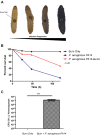An Invertebrate Burn Wound Model That Recapitulates the Hallmarks of Burn Trauma and Infection Seen in Mammalian Models
- PMID: 32582051
- PMCID: PMC7283582
- DOI: 10.3389/fmicb.2020.00998
An Invertebrate Burn Wound Model That Recapitulates the Hallmarks of Burn Trauma and Infection Seen in Mammalian Models
Abstract
The primary reason for skin graft failure and the mortality of burn wound patients, particularly those in burn intensive care centers, is bacterial infection. Several animal models exist to study burn wound pathogens. The most commonly used model is the mouse, which can be used to study virulence determinants and pathogenicity of a wide range of clinically relevant burn wound pathogens. However, animal models of burn wound pathogenicity are governed by strict ethical guidelines and hindered by high levels of animal suffering and the high level of training that is required to achieve consistent reproducible results. In this study, we describe for the first time an invertebrate model of burn trauma and concomitant wound infection. We demonstrate that this model recapitulates many of the hallmarks of burn trauma and wound infection seen in mammalian models and in human patients. We outline how this model can be used to discriminate between high and low pathogenicity strains of two of the most common burn wound colonizers Pseudomonas aeruginosa and Staphylococcus aureus, and multi-drug resistant Acinetobacter baumannii. This model is less ethically challenging than traditional vertebrate burn wound models and has the capacity to enable experiments such as high throughput screening of both anti-infective compounds and genetic mutant libraries.
Keywords: Acinetobacter baumannii; Galleria mellonella; MRSA; Pseudomonas aeruginosa; biofilm; burn; infection.
Copyright © 2020 Maslova, Shi, Sjöberg, Azevedo, Wareham and McCarthy.
Figures




Similar articles
-
Using the Galleria mellonella burn wound and infection model to identify and characterize potential wound probiotics.Microbiology (Reading). 2023 Jun;169(6):001350. doi: 10.1099/mic.0.001350. Microbiology (Reading). 2023. PMID: 37350463 Free PMC article.
-
[Analysis of distribution and drug resistance of pathogens from the wounds of 1 310 thermal burn patients].Zhonghua Shao Shang Za Zhi. 2018 Nov 20;34(11):802-808. doi: 10.3760/cma.j.issn.1009-2587.2018.11.016. Zhonghua Shao Shang Za Zhi. 2018. PMID: 30481922 Chinese.
-
[Analysis of the pathogenic characteristics of 162 severely burned patients with bloodstream infection].Zhonghua Shao Shang Za Zhi. 2016 Sep 20;32(9):529-35. doi: 10.3760/cma.j.issn.1009-2587.2016.09.004. Zhonghua Shao Shang Za Zhi. 2016. PMID: 27647068 Chinese.
-
[Bacterial ecology on burn wound and antibacterial agent therapy].Zhonghua Shao Shang Za Zhi. 2008 Oct;24(5):334-6. Zhonghua Shao Shang Za Zhi. 2008. PMID: 19103009 Review. Chinese.
-
Infection and Burn Injury.Eur Burn J. 2022 Feb 22;3(1):165-179. doi: 10.3390/ebj3010014. Eur Burn J. 2022. PMID: 39604183 Free PMC article. Review.
Cited by
-
The Virtuous Galleria mellonella Model for Scientific Experimentation.Antibiotics (Basel). 2023 Mar 3;12(3):505. doi: 10.3390/antibiotics12030505. Antibiotics (Basel). 2023. PMID: 36978373 Free PMC article. Review.
-
Phage vB_PaeS-PAJD-1 Rescues Murine Mastitis Infected With Multidrug-Resistant Pseudomonas aeruginosa.Front Cell Infect Microbiol. 2021 Jun 11;11:689770. doi: 10.3389/fcimb.2021.689770. eCollection 2021. Front Cell Infect Microbiol. 2021. PMID: 34178726 Free PMC article.
-
Hydrogel Containing Biogenic Silver Nanoparticles and Origanum vulgare Essential Oil for Burn Wounds: Antimicrobial Efficacy Using Ex Vivo and In Vivo Methods Against Multidrug-Resistant Microorganisms.Pharmaceutics. 2025 Apr 10;17(4):503. doi: 10.3390/pharmaceutics17040503. Pharmaceutics. 2025. PMID: 40284498 Free PMC article.
-
Light-activated molecular machines are fast-acting broad-spectrum antibacterials that target the membrane.Sci Adv. 2022 Jun 3;8(22):eabm2055. doi: 10.1126/sciadv.abm2055. Epub 2022 Jun 1. Sci Adv. 2022. PMID: 35648847 Free PMC article.
-
Burns and biofilms: priority pathogens and in vivo models.NPJ Biofilms Microbiomes. 2021 Sep 9;7(1):73. doi: 10.1038/s41522-021-00243-2. NPJ Biofilms Microbiomes. 2021. PMID: 34504100 Free PMC article. Review.
References
-
- Akers K. S., Schlotman T., Mangum L. C., Garcia G., Wagner A., Seiler B., et al. (2019) 653. Diagnosis of burn sepsis using the FcMBL ELISA: A pilot study in critically Ill burn patients. Open Forum Infect. Dis. 6(Supplement_2) S300 10.1093/ofid/ofz360.721 - DOI
-
- Amissah N. A., Buultjens A. H., Ablordey A., van Dam L., Opoku-Ware A., Baines S. L., et al. (2017). Methicillin resistant Staphylococcus aureus transmission in a ghanaian burn unit: the importance of active surveillance in resource-limited settings. Front. Microbiol. 8:1906. 10.3389/fmicb.2017.01906 - DOI - PMC - PubMed
Grants and funding
LinkOut - more resources
Full Text Sources
Other Literature Sources
Molecular Biology Databases

